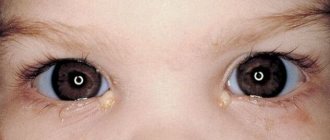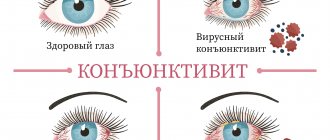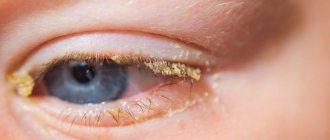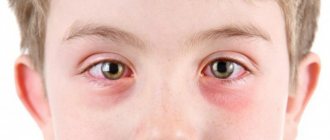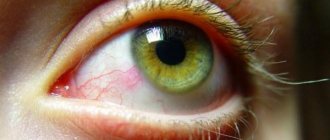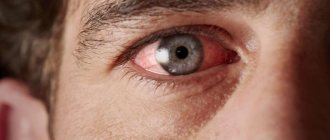The conjunctiva (“connecting”, “generalizing”) is a thin mucous membrane around the eyeball. When the eyelids, which are lined from the inside with the same mucous layer, are closed, the eye is completely enclosed in the so-called. conjunctival sac. The tasks of the conjunctiva are to minimize friction during ocular movements, and also to periodically moisturize the cornea of the eye, which, in contact with air, can dry out. With the secretion of the lacrimal glands, the liquid fraction of which is produced by the microscopic glands of the conjunctiva itself, when blinking, the cornea is cleansed of small foreign particles and receives the aseptic “lubrication” it needs.
Conjunctivitis is a group of diseases of the mucous membrane of the eye; While revealing a certain similarity in symptoms (primarily the presence of inflammation and irritation of the conjunctiva), they differ radically in the causes and mechanisms of development. Thus, according to the etiological criterion, infectious, allergic, dystrophic conjunctivitis, mixed forms (for example, infectious-allergic), as well as inflammation caused by physical or chemical factors are distinguished. There are also sporadic cases where the cause of conjunctivitis remains unknown.
Infectious forms lead the statistics; in turn, they are characterized by a wide variety of pathogens - these can be viruses, bacteria, pathogenic fungi or protozoal (protozoan) cultures. This determines the differences in the mechanisms of infection, as well as in the clinical picture, dynamics, prognosis and treatment of infectious and inflammatory processes. One of the most common types of conjunctivitis is caused by single-celled microorganisms that are considered the oldest form of life on Earth - bacteria.
What is purulent conjunctivitis?
This term hides damage to the mucous membrane of the organ of vision caused by harmful microorganisms. The main symptom of the disease is discharge of purulent exudate from the eyes. At the same time, the patient feels a strong burning sensation and fear of bright light. In severe cases, there is an increase in temperature and inflammation of the respiratory tract.
Despite the dangerous symptoms, the pathology is easily treatable if you consult a doctor at the initial stage of its development. The main patients diagnosed with purulent conjunctivitis are young children. If you find signs of inflammation in your baby, immediately visit the clinic to eliminate the risk of disease progression.
How to properly wash your eyes for conjunctivitis
To prepare the compositions, you must use only boiled water. To completely sterilize it, it must be boiled for about ten minutes, after which the solution is prepared according to the given recipe.
The eye bath or dropper should also be completely cleaned. When rinsing both eyes, the devices are processed again, this is done so that pathogens do not get from one eye to the other.
The prepared solution is filtered through gauze. Let's look at the features of different methods of rinsing the eyes:
- Pipette. Cleaning the eye with special solutions using a pipette is extremely simple - by pulling back the eyelid, you need to pour the solution onto the affected area. A common mistake is using too hot water, you need to monitor this and bring the liquid to body temperature so as not to add a burn to the disease.
- Bath, a special container for cleaning the eye. Before starting the procedure, it is sterilized and filled with a filtered solution at a suitable temperature. You need to lean over the container so as to dip your eye inside. This should last no more than a minute; in order for the cleansing to be as effective as possible, you need to blink.
- Compress. The most common way to cleanse the mucous membranes of the eye, compresses are very convenient and are used for all forms of the disease. It is performed by placing a cotton swab soaked in a medicinal composition on the eye for ten to twenty minutes.
The water used should be at or slightly above body temperature. Pathogenic organisms do not tolerate elevated temperatures well, but direct contact with hot liquid on the eye can burn it, so only hot compresses are allowed.
Before using this method of treatment, you need to make sure that the discomfort in the visual organs is actually caused by conjunctivitis. With iritis, inflammation of the iris, rinsing will be useless and even harmful. Its presence is quite easy to check; you need to close the inflamed eye and direct a beam of bright light into the other eye.
This action will cause constriction of the pupils in the eyeballs, and if the iris is inflamed, it will cause pain in the closed eye.
Causes
The development of purulent mucous conjunctivitis is caused by pathogenic bacteria and viruses. In some cases, the disease goes away on its own, even if the wrong treatment was chosen or the patient sought medical help late. The main advantage of early therapy is that the risk of complications is eliminated and recovery will occur much faster.
The causative agents of the disease are staphylococci, pneumococci, streptococci. They penetrate the mucous membrane of the eye due to failure to comply with basic hygiene rules. For example, if a person touches his eyes with unwashed hands, wipes his face with someone else’s towel, or remains in conditions of severe environmental pollution for a long time.
In adults, the disease can be triggered by increased activity of chlamydia or the appearance of gonorrhea pathogens in the body. In this case, it is enough to use his personal belongings, on which particles of pathogenic microbes are stored. Gonorrhea or chlamydia enter the body after unprotected sexual intercourse; the anomaly does not always affect the genitourinary system; it can “act out” on the visual apparatus.
| Pets can spread purulent conjunctivitis. A significant role in the development of the anomaly is played by a malfunction of the immune system. |
Return to contents
How to properly wash your baby's eyes?
During treatment, eye rinsing is also necessary. It eliminates pathogens and their metabolic products. This procedure should be carried out at least three times a day. It is especially important to rinse your child in the morning or after a nap; during this period, the secreted substance accumulates in the corners of the eyes and dries, literally sticking the eyelids together.
Additionally, the doctor will prescribe various ointments and drops, which are used in parallel with solutions and compresses. The latter contribute to the greater effectiveness of medicinal preparations, since they help eliminate accumulated secretions and avoid their hardening, reduce the degree of bacterial or viral infection, and soak dried crusts.
Rules for the rinsing procedure for conjunctivitis:
- for diluting products and infusing, you can only use boiled water, and for complete sterilization it must boil for at least ten minutes;
- if additional instruments are used to wash the child’s eyes, they must also be sterilized in boiling water or treated with antiseptics. After performing the procedure on one organ of vision, the instruments are processed again before moving on to the other. This is necessary in order not to transfer pathogens from one eye to another;
- the healing infusion or solution must be carefully filtered, for example, through several layers of gauze.
Eye rinsing in children can be done not only with clean napkins or cotton pads. The use of additional tools can increase the efficiency of the procedure.
What devices are recommended to be used for children:
| Tool | How is the procedure performed? | Things to consider |
| Pipette | Cleaning children's eyes is very simple here: you need to pull back the eyelid and drip a large amount of the product onto the affected area. | Do not use too hot water to avoid burning the eye tissue. |
| Eye cleansing bath | The washing container is sterilized and filled with carefully filtered medicine. The child bends over the bath so that the eye is in the liquid. | The solution or infusion should also not be hot, and the procedure itself lasts longer than a minute. For the cleansing to be most effective, you should blink. |
But with this disease, cotton swabs soaked in drugs or healing infusions can be applied to the eyes for no more than a quarter of an hour. It is better if the temperature of the compress infusion is slightly higher than body temperature. Infectious agents “do not like” a warm environment. But you should also not apply excessively hot compresses, so as not to burn the mucous membrane.
Risk factors
Inflammation of the eye with discharge of pus can be caused by:
- Acute respiratory viral pathologies (ARVI);
- Diseases of the ears, nose or throat (otitis media, sinusitis);
- Entry into the visual apparatus of a foreign body;
- Mechanical injury to the eye;
- Ophthalmic ailments (blepharitis, dry eye syndrome);
- Malfunction of the immune system;
- Prolonged exposure to stress;
- Hypothermia;
- Prolonged treatment with corticosteroids;
- Erythema multiforme.
For mucopurulent conjunctivitis, it is not recommended to apply bandages, since they inhibit the outflow of exudate; as a result, inflammation can move to the cornea.
In newborn babies, the anomaly is caused by:
- Birth ahead of schedule;
- Infection of the fetus in the womb;
- Inflammatory diseases of the genitourinary system in a pregnant woman (for example, gonorrhea).
Symptoms (signs)
Bacterial conjunctivitis has a number of distinctive features in comparison with other infectious conjunctivitis. In particular, a viral infection is transmitted by airborne droplets, while a bacterial infection is transmitted by contact, incl. through unwashed hands, contaminated towels, pillowcases, etc. Hence the age-related differences in epidemiological data: in adults the ratio of viral to bacterial conjunctivitis is 5.6:1, while in children these frequencies are approximately the same. In general, the incidence of infectious conjunctivitis in childhood is much higher, which is explained by the very high contagiousness of the main pathogens, the characteristics of children's groups, the infantilism of the immune system, and the lack of automated hygiene skills. Most often, bacterial conjunctivitis acquires the proportions of local epidemic outbreaks, so it is advisable to immediately exempt a sick child from visiting a child care facility.
There is also a real danger of infection of the newborn during passage through the birth canal if the mother’s urogenital infection is not treated in a timely manner.
Bacterial conjunctivitis is usually characterized by a violent, acute onset in one eye with possible involvement of the other. Typical signs are conjunctival hyperemia (redness, excessive blood filling of the vascular network), swelling, lacrimation, complaints of “sandy pain” and/or burning. The main symptom is mucopurulent exudate, which accumulates in especially large quantities during sleep and forms crusts (“sour eyes”), therefore, bacterial conjunctivitis is sometimes called “ purulent ”, and therefore the application of any bandages to the affected eye is contraindicated. In rare and most serious cases, ulcerative lesions of the cornea, retinitis, blepharitis, keratitis and their combinations may develop.
Classification
Depending on the type of “pest” that caused the development of inflammatory processes in the organ of vision, the disease is divided into the following categories:
- Gonococcal;
- Staphylococcal or streptococcal;
- Pseudomonas aeruginosa.
The first type of purulent conjunctivitis in infants develops three days after birth from an infected mother infected with gonorrhea. This pathology is extremely rare, since pregnant women undergo a thorough medical examination before childbirth. This phenomenon can be encountered in asocial families where the expectant mother did not consider it necessary to register with the antenatal clinic.
| The disease can be transferred from the genitals to the organ of vision by the sick person himself. The main danger of gonococcal conjunctivitis lies in the fact that it affects the cornea. If treatment is not started in time, you can permanently lose your vision. |
To become infected with a staphylococcal or streptococcal disease, only minor contact with a carrier of the infection (for example, shaking hands) is enough. It is also dangerous to use things and personal hygiene items that the patient has touched. In addition, this type of conjunctivitis affects the body after suffering an inflammatory disease of the upper respiratory tract.
The acute period lasts from one to two weeks. The clinical picture develops very quickly, with pronounced symptoms. If treatment is not started in time, the anomaly will enter the chronic stage. In this case, the abundance of discharge decreases, the signs become almost invisible, but the pathology is difficult to treat.
Pseudomonas aeruginosa enters the body as a result of microscopic damage to the visual apparatus, if the rules for storing and wearing contact lenses are violated due to the penetration of dust and dirt into the eyes. As a rule, this type of purulent conjunctivitis affects only one eye.
The initial signs of pseudomonas inflammation are increased sensitivity to light and increased lacrimation. Then pus is released, erosions form on the surface of the cornea, through which the infection enters the deeper layers of the eye. In some cases, progression of keratitis is observed. Subsequently, scars appear at the site of erosion, significantly reducing visual acuity.
Return to contents
Symptoms
Main signs of the disease:
- Intolerance to bright light;
- Swelling of the eyelids;
- Feeling of a foreign object in the eyes;
- Unbearable itching;
- Burning;
- Increased lacrimation;
- Malaise and weakness;
- Increased body temperature;
- Pus is released from the organ of vision, gluing the eyelids;
- Overflow of blood vessels and conjunctiva;
- Inflammatory processes in the upper respiratory tract.
| Depending on the type of infectious agent, symptoms may be more or less pronounced. Sometimes only some of them appear. |
Types of canine conjunctivitis
Conjunctivitis in dogs is divided into 4 types, each of which requires different care.
According to the international classification, conjunctivitis in dogs is divided into 4 types, each of which is characterized by specific signs, pathogenesis and manifestations:
- Catarrhal conjunctivitis , in most cases, occurs with traumatic lesions of the eye shell, as well as against the background of infectious diseases. This form of the disease manifests itself as redness and increased swelling of the conjunctiva (up to its complete protrusion from under the eyelid), hyperemia, profuse eye discharge, which is serous or purulent-mucosal in nature.
- The purulent type of conjunctivitis develops when bacteria and pathogenic pyogenic microorganisms come into contact with the mucous membrane of the eye. Typically, the purulent form of conjunctivitis in dogs simultaneously affects both eyes and occurs exclusively in an acute form, characterized by rapid development. The purulent type of pathology manifests itself with such signs as swelling of the eyelids, increased body temperature, the presence of photophobia, as well as blepharospasms. Purulent conjunctivitis is characterized by thick eye discharge, grayish-yellow in color with a very unpleasant odor, which dries and forms specific crusts in the area of the eyelids, eyelashes and corners of the eyes. In particularly severe cases, clouding of the eye cornea may occur. This form of conjunctivitis requires prompt, timely treatment, as it is fraught with complete loss of vision for the animal.
- Allergic conjunctivitis - observed in dogs with an increased tendency to allergic reactions. The inflammatory process begins when any allergen comes into contact with the conjunctiva or mucous membrane. In this case, specific symptoms are observed in the form of profuse lacrimation, redness of the eyelids and the eye itself.
- Follicular conjunctivitis - occurs when the eye shell is exposed to dust, smoke or particles of foreign bodies that affect the lymphatic follicles of the eyelids or as a complication of the catarrhal form of conjunctival disease. Characteristic symptoms of follicular conjunctivitis are severe redness of the eye membranes, intense purulent discharge, as well as an abundant accumulation of lymphatic follicles in the area of the inner surface of the eyelids.
Possible consequences and complications
If you choose the wrong type of therapy or consult a doctor too late, purulent conjunctivitis can cause serious complications:
- Accumulation of pus in the anterior chamber of the eye;
- Development of chronic blepharitis;
- Lens loss;
- Destruction of corneal tissue;
- The appearance of scars on the conjunctiva.
The disease most often affects people with a weakened immune system after suffering a viral or infectious disease (dystrophy, anemia, etc.). In children, the disease can cause progression of keratitis and dacryocystitis.
Diagnostics
It will not be difficult for an experienced ophthalmologist to identify the pathology, since it has characteristic signs. To find out the type of pathogen and determine the level of sensitivity of the patient to a certain group of antibiotics, additional laboratory tests of the exudate are prescribed.
A smear of mucus is taken from the affected eye, examined under a microscope (bacterioscopy) and sown on a nutrient medium to accurately determine the colony of bacteria. If there is a suspicion of damage to the cornea, an installation test with fluorescein is performed.
Treatment of purulent conjunctivitis in adults
An integrated approach is needed to treat the disease. Antibacterial drugs (Albucid, Ciprofloxan) must be prescribed. Before applying the ointment to the affected eyelid, treat it with Furacilin solution or chamomile decoction.
To get rid of unpleasant symptoms, purchase Visine or Artificial Tear eye drops; they will moisturize the eyelids and prevent them from sticking together. Do not use tight bandages under any circumstances, you will only make your situation worse!
Immunologist Andrey Prodeus will talk about the treatment of conjunctivitis in the video.
Return to contents
Medication
The main drugs aimed at treating purulent inflammation are Actipol, Albucid, Oftalmoferon. The ointment is placed behind the affected eyelid and left overnight to enhance the antibacterial effect. Treatment is continued until the symptoms of the disease are completely eliminated.
Staphylococci are highly resistant to drugs, so fluoroquinolones (for example, Ofloxacin ointment 0.3%) are used to eliminate conjunctivitis caused by such bacteria. Children should not be given antibacterial drops that contain antibiotics.
How to treat purulent conjunctivitis in adults (the order of therapy should not be violated in any case):
- Every day after waking up, clean your eyes of accumulated pus. A weak solution of potassium permanganate is suitable for these purposes. Soak a swab in it or use a clean syringe without a needle. You need to rinse the affected eye several times during the day when pus appears;
- Every hour (or according to the individual recommendations of the ophthalmologist), instill the drug prescribed by the doctor;
- Before going to bed, place tetracycline ointment in the conjunctival sac.
When the acute stage of the disease has passed, the drops can be instilled six times a day.
ethnoscience
Grandmother's recipes effectively fight purulent conjunctivitis, if it is not advanced.
- Make lotions from chamomile infusion four times a day. To do this, pour a tablespoon of dried flowers into a glass of boiling water and let it brew;
- The most effective and affordable way is lotions made from black or green tea. Brew a weak drink, cool and use for compresses;
- Take fresh dill, wash it well and squeeze out the juice. Then soak gauze or a cotton pad in it and apply it to your eyelids, leave for fifteen minutes. An infusion of greenfinch seeds effectively fights purulent inflammation. To prepare it you will need a glass of boiling water and a teaspoon of dill seeds;
- Rinse your eyes with rosehip decoction. Pour a glass of water over a couple of crushed berries and boil for ten minutes. After the infusion has cooled, it can be used;
- Prepare a mask from raw potatoes. Grate the fruit and combine it with egg white, apply the mixture to the eyelids for fifteen minutes;
- Eye drops can be prepared at home. Combine one part honey with two parts water, mix everything well and bury it. The product is also suitable for compresses; store the composition in the refrigerator;
- Lubricate your eyelids, wash your eyes, prepare lotions and drink - all this can be done with plant juices. Juice made from parsley and carrots in a ratio of 1:3 works well for purulent conjunctivitis. Drink it three times a day, one hundred grams before meals.
| Remember that all traditional medicine recipes can be used only after consultation with the doctor. |
How to prevent the occurrence of eye pathology
Prevention of conjunctivitis in dogs consists, first of all, in compliance with sanitary and hygienic standards and proper care of the pet. The dog's sleeping place must be dry and clean; it is recommended to change the bedding every week.
Regularly, and preferably every 2 days, it is recommended to wash the animal’s eyes with cotton swabs soaked in chamomile infusion or tea leaves.
In addition, you need to pay attention to your pet’s diet, making sure that the food is as balanced as possible and that it certainly includes foods rich in vitamins A and E.
We recommend reading: How Long Can a Kitten Have Diarrhea When Changing Food?
It is imperative that you exclude or at least limit your pet’s contact with people or other animals suffering from conjunctivitis. During walks, you should not allow your pet to play in dust, dirt or sand to prevent particles from getting on the mucous membrane of the eye.
Conjunctivitis in dogs is a fairly serious and dangerous disease that affects the visual organs of a pet. However, proper care, timely treatment and compliance with the recommendations of a veterinarian will help you quickly overcome this disease, avoiding possible complications and unpleasant consequences!
This kind of therapeutic procedures are carried out 3-4 times a day, for 1-2 weeks, it depends, first of all, on the condition of the pet.
Treatment of purulent conjunctivitis in children
The fight against the disease is complex. It is necessary to rid the baby of unpleasant symptoms that cause discomfort and pain as soon as possible. It is more difficult for children to suffer from the disease due to their age.
Of the antibacterial agents, Tobrex, Tsipromed, etc. are most often prescribed. Eye drops "Oftadek", ointments "Floxal", "Tetracycline" effectively fight conjunctivitis. There are complex drugs, like Tobradex.
Return to contents
Prevention
The following recommendations will help you avoid the development of a dangerous and unpleasant disease:
- Always and everywhere observe the rules of personal hygiene;
- If you work in highly polluted conditions, use protective equipment;
- Do not use other people’s cosmetics and do not lend yours to anyone;
- When an employee with purulent conjunctivitis appears in your team, try to avoid contact with him;
- Do not rub your eyes on the street or at a party, as this will easily introduce an infection into them;
- Once every seven days, wet clean your home;
- Introduce into your diet foods rich in nutrients and vitamins that will strengthen the immune system.
| To minimize the risk of developing conjunctivitis in infants, special prevention is provided in the maternity hospital. |
Solutions for children
When treating a child, you must be careful; you should not experiment with different solutions, risking further harm to him.
Unexpected allergic reactions, individual intolerance to certain substances, inconsistency of the solution used with the age of the child - these are the most well-known mistakes.
When faced with the disease for the first time, it is better to first contact your pediatrician, he will indicate how to wash your eyes for conjunctivitis in children.
However, by the discharge you can independently diagnose conjunctivitis of a bacterial or viral nature, in which case you can use Albucid. Inflammation accompanied by pain, in which there is no discharge, is a direct sign of an allergic form; with it, you can use mild antihistamines (tablets, suspensions), making sure that they are harmless to the child; there is no need to wash the eyes.
Having discovered that the inflammation is caused by infection with harmful bacteria, you can use gentle solutions to clean the eyes, for example, chamomile infusion or furatsilin in the ratio of one tablet to half a glass of water. You need to rinse your eyes in the direction from the temple to the nose; if only one eye is affected, the second one is also washed.
For infants, you can use a 10% solution of Albucid; for older children, it is permissible to use Fucitalmic, Levomycetin, Vitabact and others.




